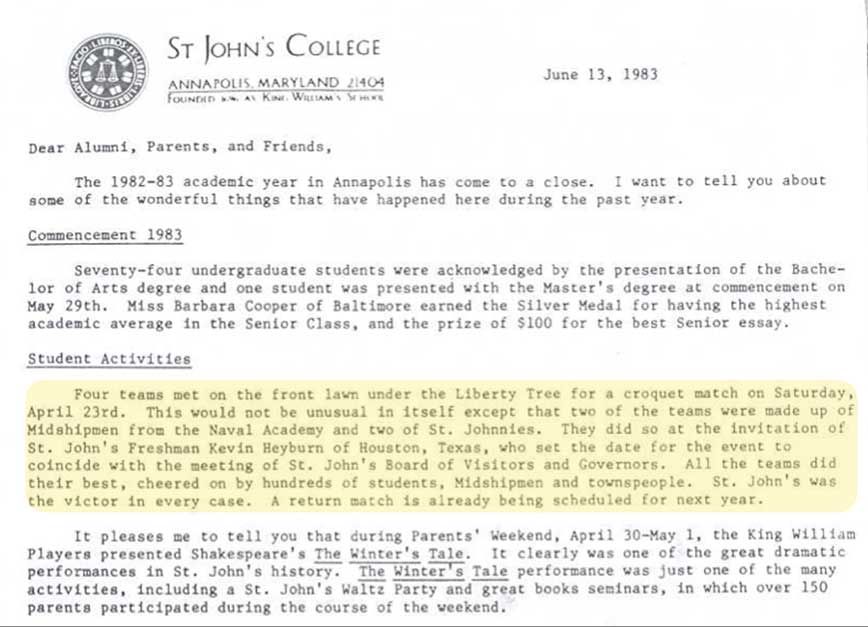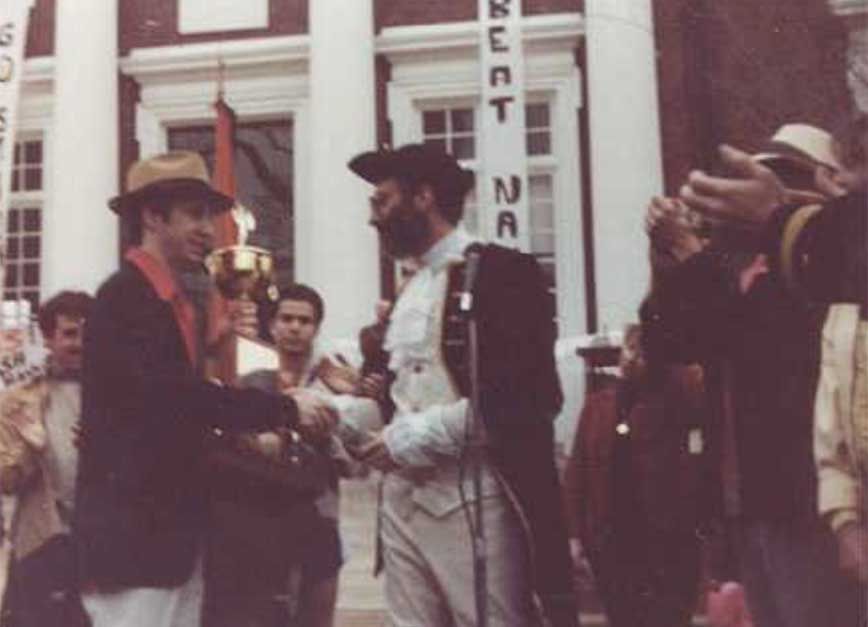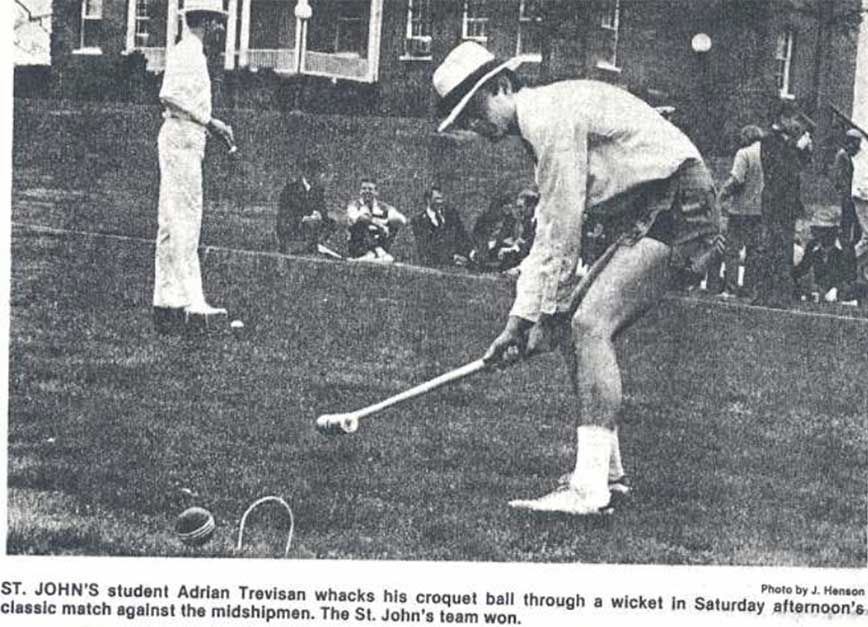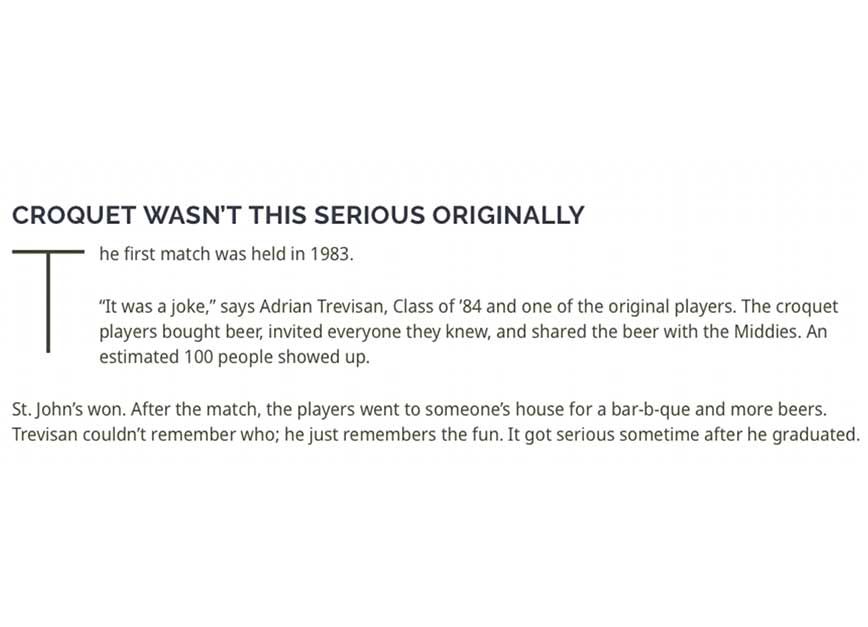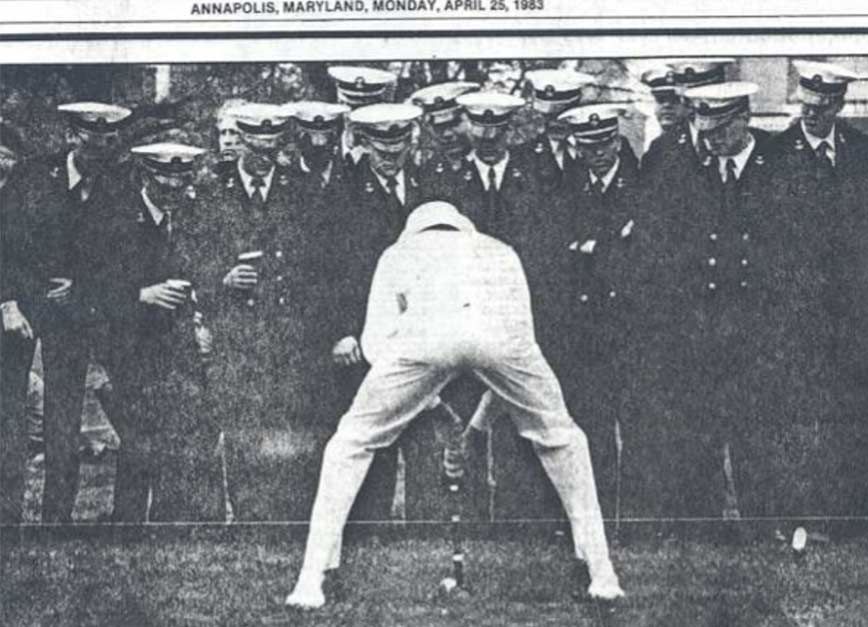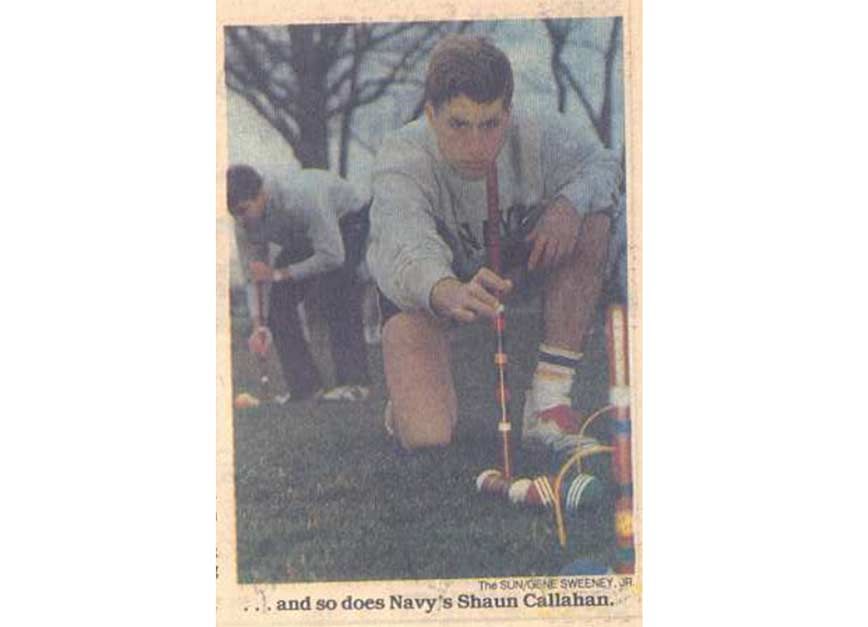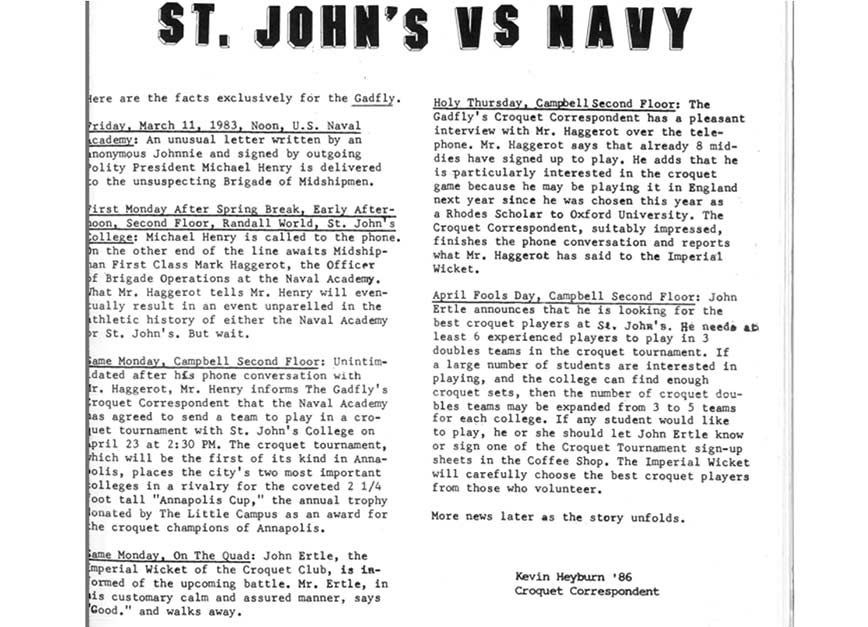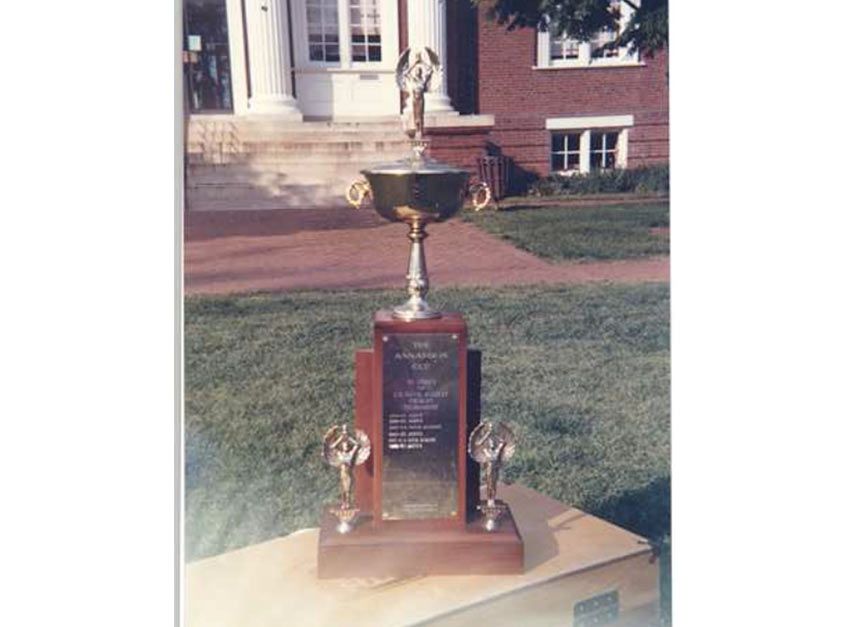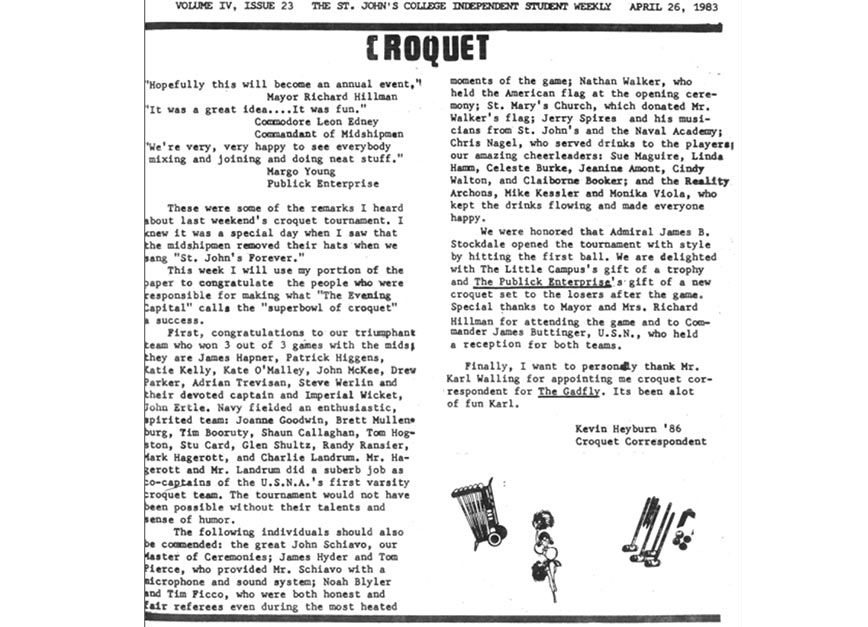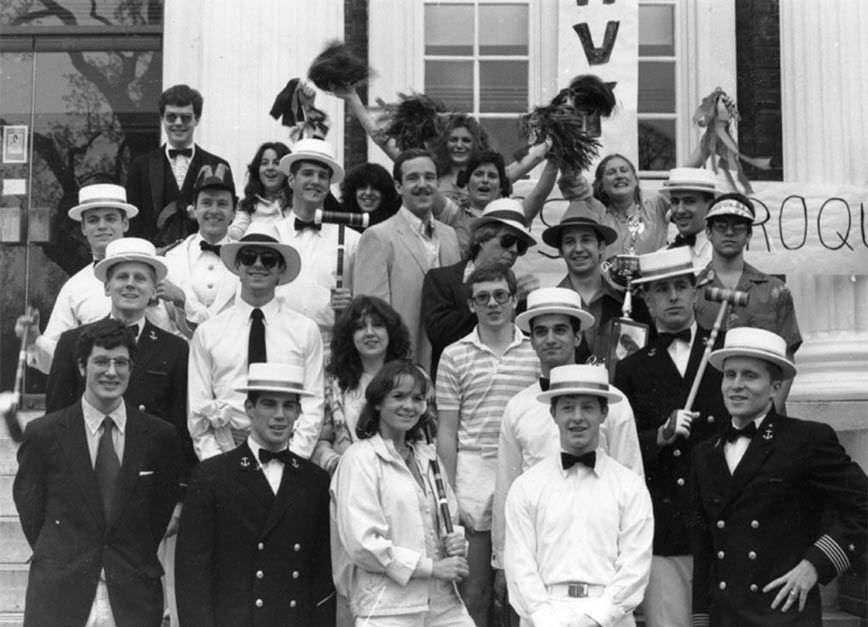St. John’s College Croquet
Celebrating Forty Years of Unfettered Passion
By the Rusty Wickets
In Honor of the Inauguration
of President Nora Demleitner - Spring 2023

Croquet in America
Croquet came to the United States in the early 1870s, and quickly grew in popularity among New York’s high society. By the 1880s, croquet players far outnumbered tennis players, and no eastern estate would be seen without a proper croquet set. Municipalities, wanting to improve lifestyle and attract more residents, began to purchase croquet sets and leave them for check-out at their parks and public fields.
One hallmark of the game that helped its popularity surge: it was one of the first games played in the United States by men and women, with women routinely trouncing the men. Even today, some of the very best croquet players in the world are women, competing against men, and beating them.

“The Immoral Practice of Croquet”
By the 1890s, the devout responded to men and women competing together.
In a magazine editorial, Rev. Skinner of Boston said of croquet: It is the gaping jaw of Hades. It would be well if the clergy and laity were enlisted for suppressing the immoral practice of croquet.
The city of Boston promptly banned the sport and other towns and cities along the east coast followed suit. Many believed good Christian ladies should not be seen playing a game with men.
What began as a radical, if unwitting, experiment in gender equality, soon became a convenient scapegoat for the power brokers on the east coast. As croquet left the Boston Common, it continued to be played in an unlikely place, the Great Plains of America.
Outlaws, Scofflaws, and Ragamuffins
As proper and polite society out east clamped down on and virtually eliminated croquet, the sport grew on the plains and throughout the American West.
Pictured here is the fastest gun in the West, Billy the Kid, playing the game with a flare that any St. John’s player will recognize.
It is believed that folks out west picked up the game not in spite of the East Coast bans, but in large part, because of them.
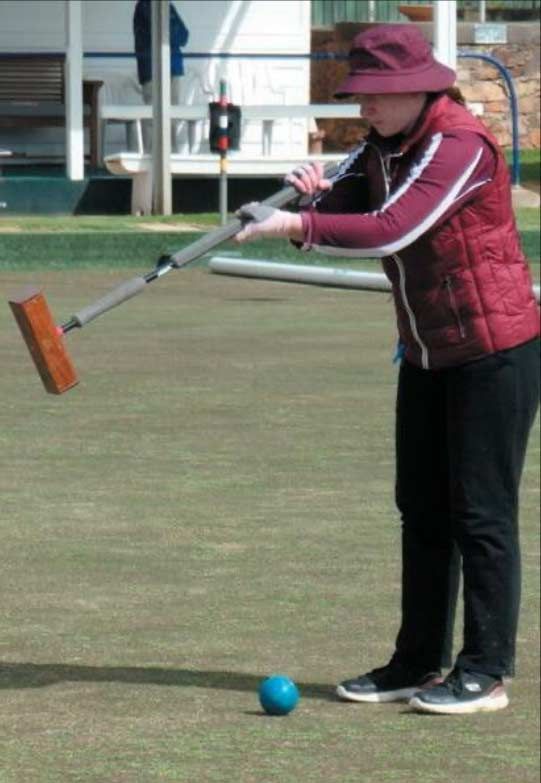
A Dichotomy Emerges
The bans on croquet eventually gave way to the times, and after the war the game became a pleasant pastime for grandparents and their grandkids. Horseshoes, badminton, and croquet became backyard activities at every summer cookout.
Gone were the elegant, custom made estate sets, with their exotic woods and cast iron metal. Post-war American croquet featured cheaper, mass-produced sets, with wide hoops, and house rules.
But some parts of our society continued to play croquet “the old way.” Manicured greens became standardized, mallet weighting and materials became hightech, six-wicket rules became official, and tournaments abounded.
These two worlds never really met. High level croquet was played at the country club or the resort, while backyard croquet was played by the masses.
But through kind fate, one place emerged where these two worlds combined … The front campus of St. John’s College.
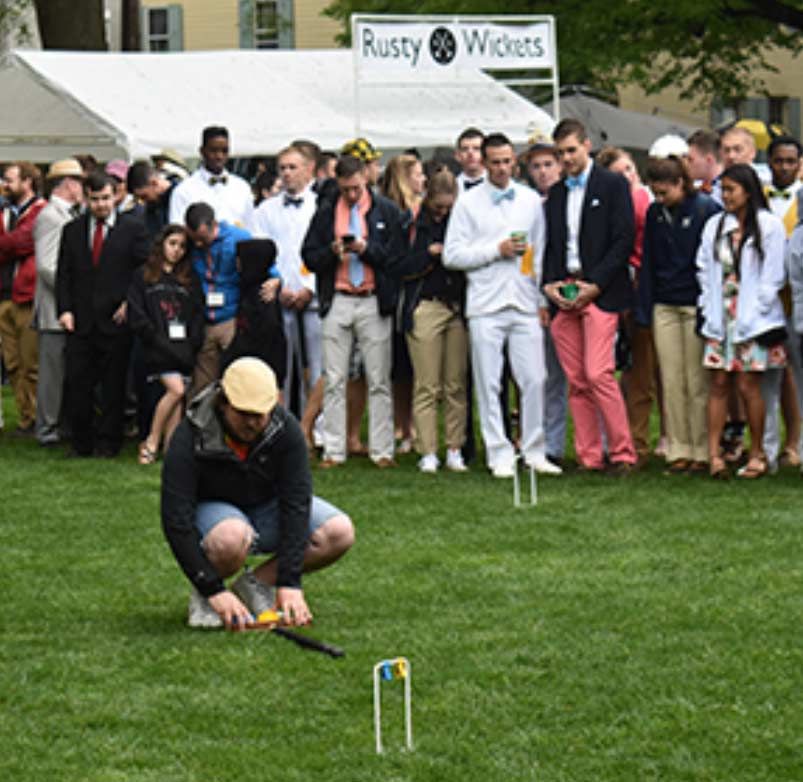
The Front Campus Unity
St. John’s College croquet plays nine-wicket which is the backyard version. But they use their own version of American six-wicket rules, and professional level equipment.
Front campus is not manicured, and the randomness generated by the natural environment keeps all games close and competitive.
Over the years, our team has synthesized the best of both versions of croquet:
Women and men on an equal footing, the random chaos of nature, a certain outlawesque joie de vivre, and a thoroughly egalitarian mindset with an emphasis on civility.

Desperate Times Call for Despots
To maintain the fragile unity between the dichotomy of croquet, and to keep natural chaos from overwhelming the greensward, the St. John’s croquet team has always been ruled by the office of the Imperial Wicket, endowed by the Gods to maintain the rules and decorum of the game.
The Imperial Wicket of St. John’s College is the last bastion of pure tyranny in an otherwise free, democratic, and civilized world. While many Wickets have served as benevolent rulers, it sometimes takes a true tyrant to keep our shots straight.
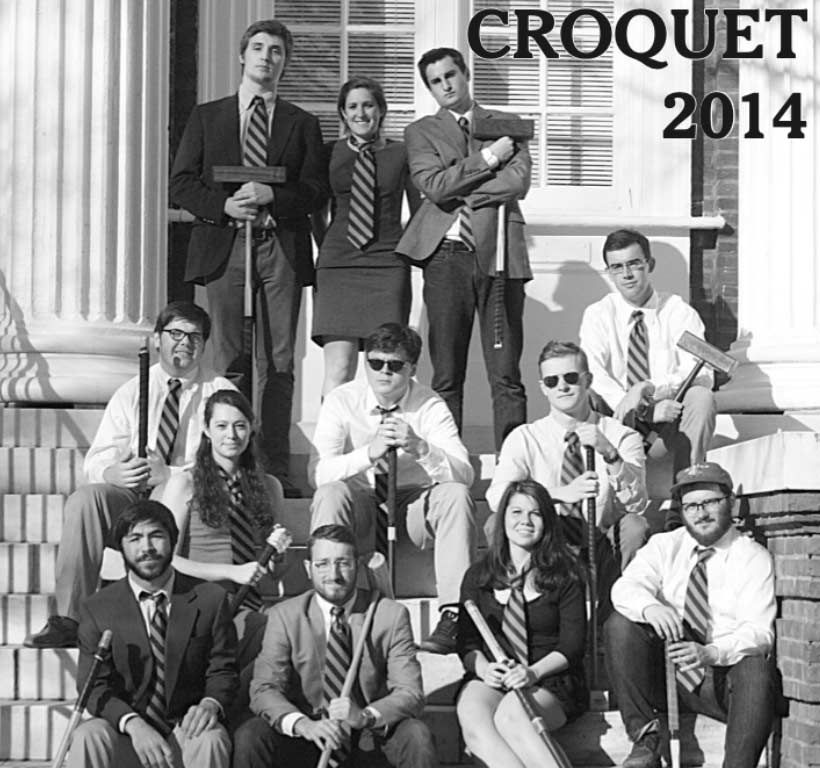
Why Croquet at St. John’s?
Our program is heavy on discourse and discussion, and those discussions continue on the greensward. With no time limit, some turns can last 20 minutes or more, allowing the other players sufficient time to read their books, discuss their labs, and compare translations in between turns.
The conversations continue from the croquet courts and back to the classrooms. A certain gentility is required to work out differences over sometimes Byzantine croquet rules. That same requirement is found in our seminars and tutorials to help better aid mutual understanding.
The Program and croquet go hand in hand.
In addition to the conversations, there is the point Eva Brann often makes: the word “school” comes from the Greek σχολή.
There is perhaps no more leisurely activity Johnnies can engage in than a serene game of croquet on front campus. With ample time to reflect, the croquet courts become a sort of oasis for college students needing a healthy way to decompress.
Yet, probably the single reason croquet has endured at St. John’s is because of the friendships the team creates. Drawing from every part of the polity, the croquet team bonds together through friendly competition and an annual rivalry like no other in America.
1983-1991
The Founding Generation
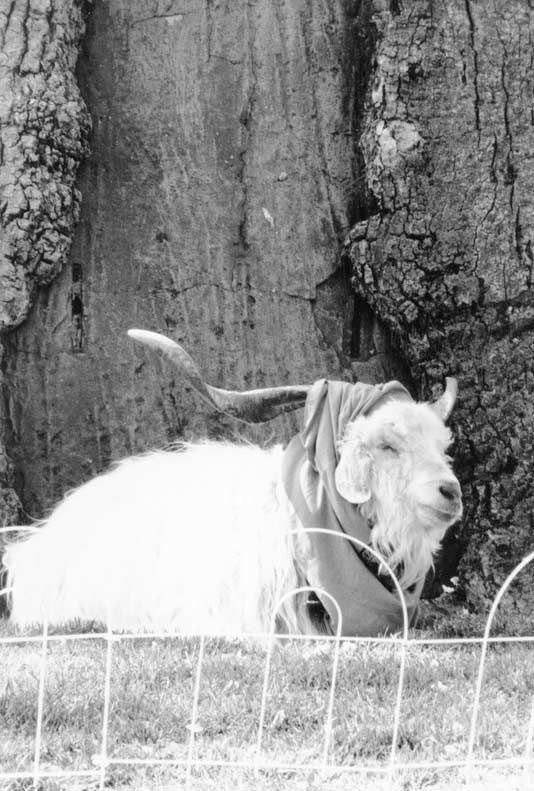
Pranks
1983-1991: Founding Generation
Pranks during the founding generation were a standard part of the match. Midshipmen would often coat the Liberty Tree in shaving cream before the match (no one is sure why).
St. John’s students would often heckle the midshipmen while they were taking their turns.
And at some point, someone stole the Navy goat and brought him to the match.
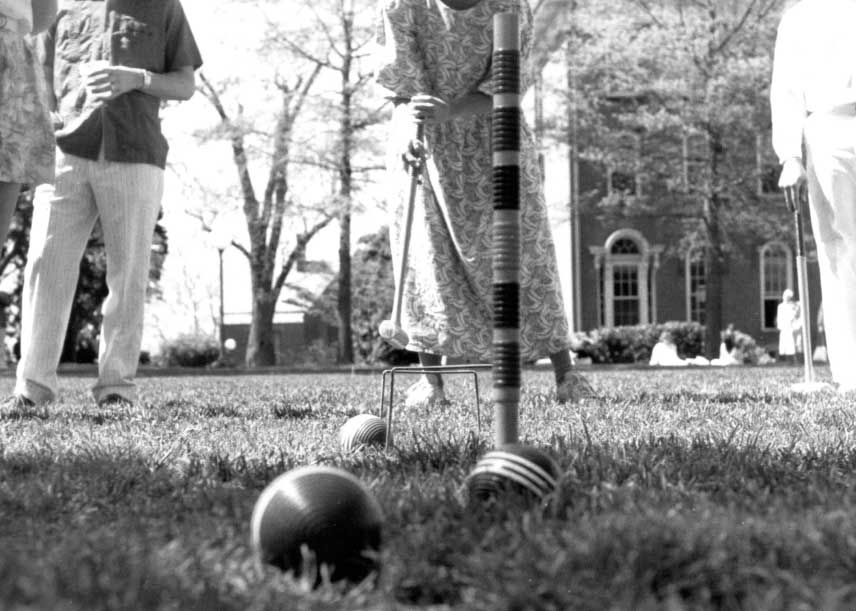
The Equipment
1983-1991: Founding Generation
From 1983 up until around the reign of Imperial Wicket Craig Sirkin, the team used backyard variety croquet ware. Short wooden mallets, single milled wooden balls, and wide hoops were laid out in a nine-wicket court pattern. These sets made the game easier to play, but also required the courts to be much smaller than the official nine-wicket dimensions and did not allow for the sophisticated strategies and techniques used by today’s players.
1992-2000
The First Golden Era: St. John’s College Croquet
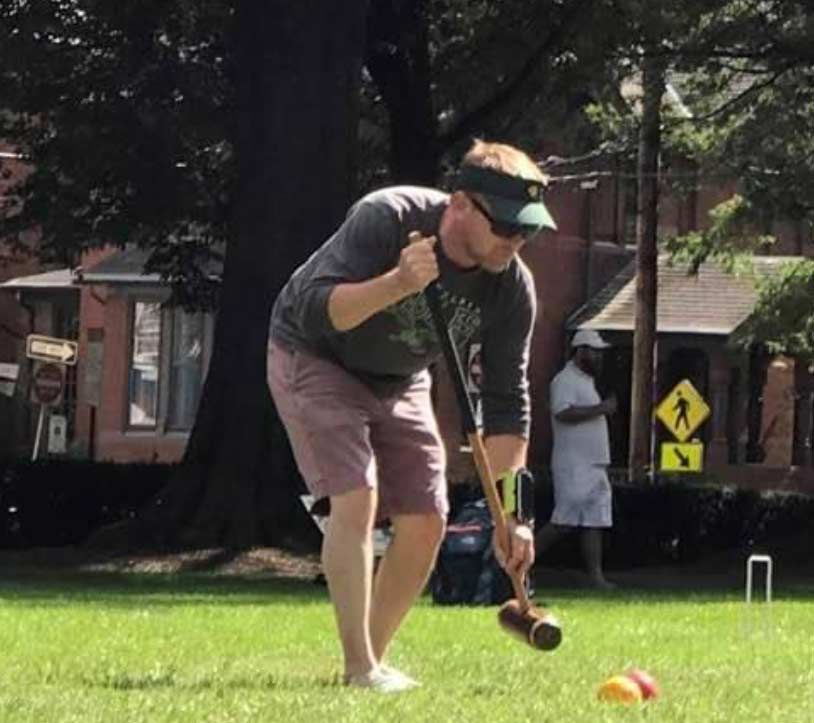
The Equipment
1992-2000: The First Golden Era
In the 1990s the team experimented with more difficult to wield arms (heavier balls, heavier mallets, narrower wickets). The prior generation’s backyard mallets and hoops (Class D), were replaced with Class B, and sometimes A. These upgrades were required in order to compete on the manicured greens at USCA Collegiate Nationals.
Though mallets were still far too light for the balls used by professionals, the team’s strategy and high velocity shot taking managed to give them an edge.
These teams secured our first Runner-up at Nationals in 1996, our first National Championship in 1997, our first repeat National Championship in 1998. After this era, the only time some other college won nationals was when the Johnnies didn’t compete. Of course, these teams also beat Navy nine times in a row.
No other Era has equaled or exceeded nine straight Annapolis Cup victories.
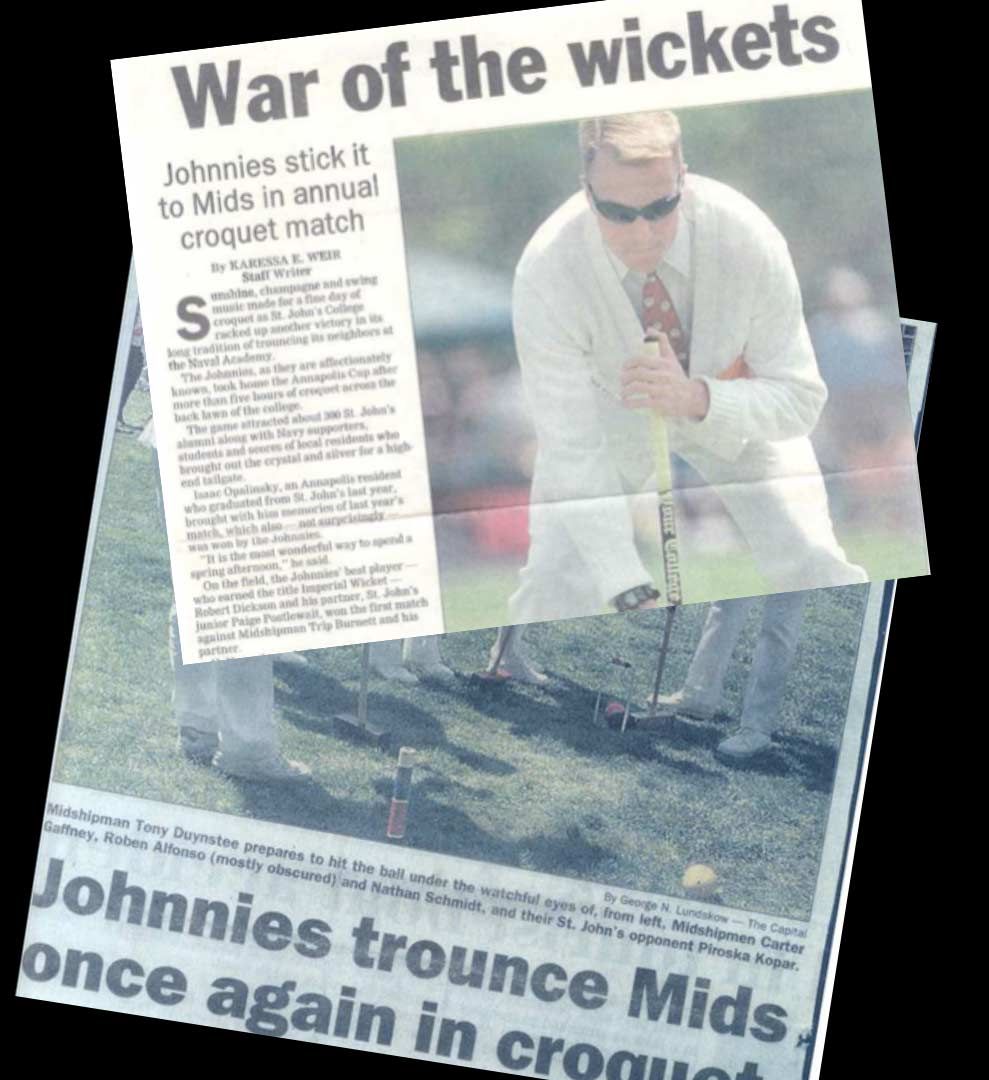
The Strategy
1992-2000: The First Golden Era
During the 1990s and early 2000s, the team’s strategy was characterized as highly defensive, and almost cruel at times. The goal of moving through the course as quickly as possible was totally supplanted by the strategy of laying a trap for the unwary opponent.
Once the trap sprung, the game was over from a mental and moral view. All that remained for the Johnnies was the somber task of doing away with the corpses and any other refuse left on their greensward.
This strategy proved unparalleled as it conquered the midshipmen nine straight times, and won our first four National Championships in only five years of USCA competition.
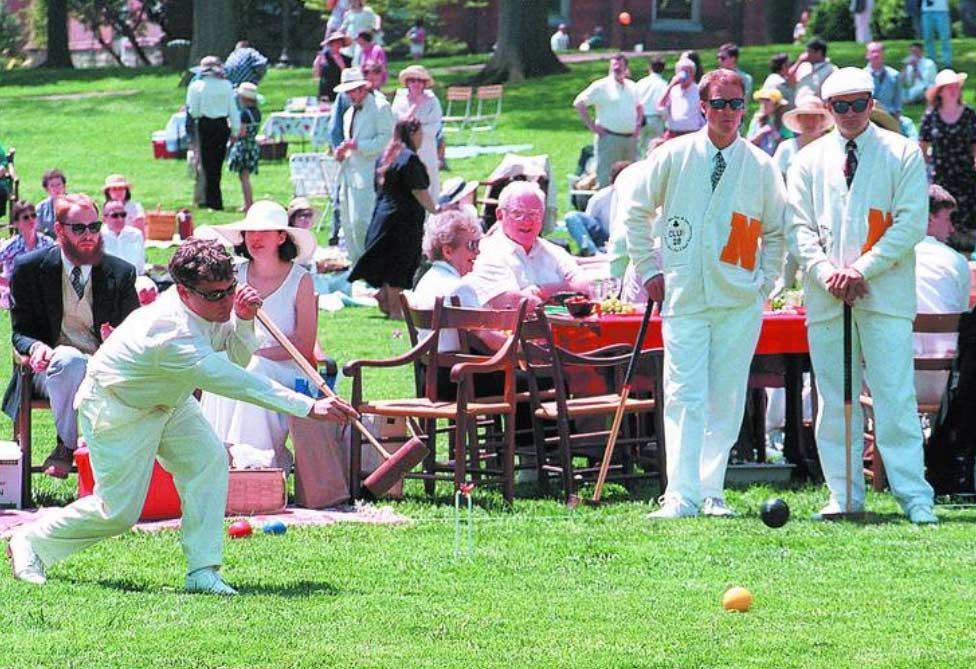
The Techniques
1992-2000: The First Golden Era
In this period, the first players to complete the course in one turn were recorded, demonstrating an increasing command by the Johnnies of medium to short range shots, all while running breaks with the next three moves in mind.
Players became adept at jump shots, and continued to hit the balls with so much force and speed that some grizzled professionals from Merion Cricket Club (a USCA venue) spilled their drinks.
The 1990s were characterized by high velocity, mostly airborne shots, which seemed to be guided to their targets by some sort of autonomous intelligence.
All of it still pulled off with effortless ease while sipping an icy cold beverage.
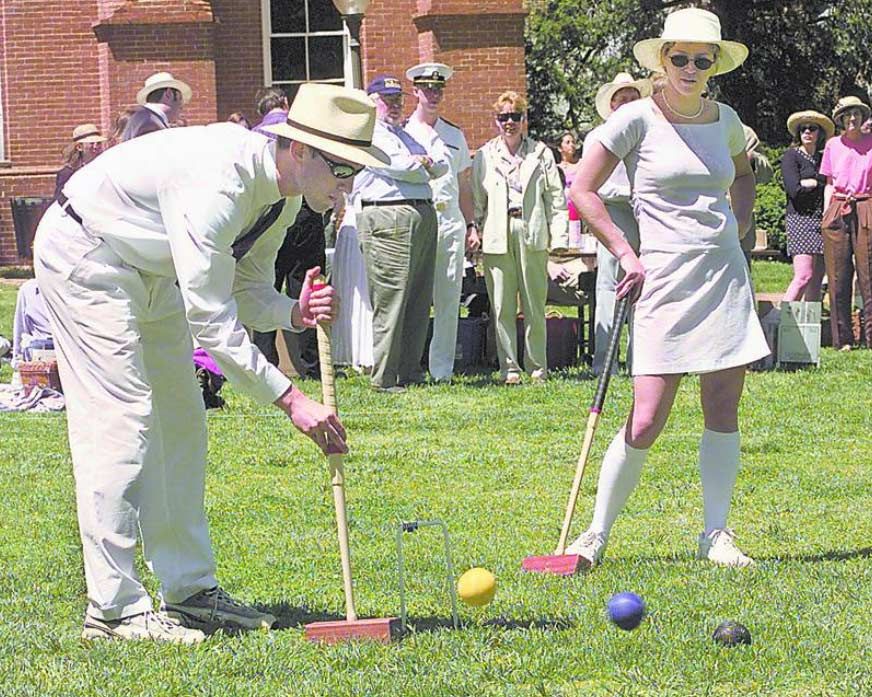
The Rules
1992-2000: The First Golden Era
With the purchase of new equipment came exposure to the rules of the USCA, and the bastardization of ninewicket by that august organization.
Johnnies responded by standing fast to certain “no negotiation” positions:
The infinite rover rule, no way we giving that up
Staked rover sits for two turns then must stake back in
“Touching is in” on the boundary line, to make match play less argumentative
Crush shots were “illegal” but no one cared so long as you went through
The opening was still a bit messy during this time, everyone went 3 live after turn 1, even if they hadn’t cleared first wicket, leading to weird results in turns 2-4.
STILL NO TIME. AND NEVER SHALL THERE BE!

The Camaraderie
1992-2000: The First Golden Era
Due to the increasing use of a strategy that was meant to confuse and ultimately demoralize the opponent, intracollegiate play on campus was a hot mess. Mallets, balls, wickets, and occasionally deadness boards, were hurled in indignation, although never at someone (except once, and that was a mistake, we fixed that problem).
On any given afternoon in the 1990s, 15-25 Johnnies could be seen on front campus playing croquet, drinking a beer, and doing their reading in between turns. It is rumored that gambling on games became so lucrative some students never had to work again.
Each Imperial Wicket in this era felt duty bound to pick a successor and make them better.
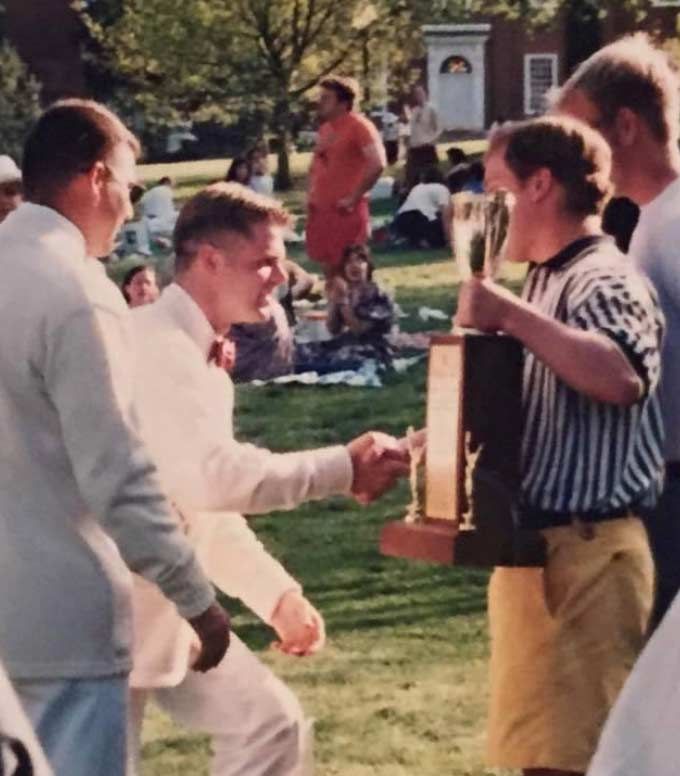
The Match Itself
1992-2000: The First Golden Era
Annapolis Cups in the 1990s featured hundreds of people (instead of thousands), and short match times (due to the Johnnies’ dominance over USNA). Many players in the 1990s were forced to “slow down” because their match (and their senior year) would be over too quickly. While the rivalry was spirited, there was never any doubt of the outcome in these times.
The tradition of a “senior team” started in this era, where two seniors with no croquet experience were plucked by the Imperial Wicket to play in the Annapolis Cup.
The sole job of the senior team was to lose gracefully, so the match would be scored 4-1 instead of 5-0 (giving the Mids just enough of a taste of victory to keep coming back for more). Regrettably, even some of our worst seniors were just too good for Navy.
There were no costumes for the Johnnies in this era, preferring their own individualistic approach in contrast to the uniformed Midshipmen.
What the Players Say
1992-2000: The First Golden Era
What made this era so special? In my mind, it’s gotta be Craig Sirkin. He and his
partner Micah Pharris really raised the bar, and set the standard for those of us still
coming up. They made us care about the result. It was no longer just an excuse to
drink beer, although that certainly wasn’t shunned. And the goal wasn’t just winning,
but winning well.
Look sharp on the court. Exhibit good sportsmanship. Never celebrate a win until after
you shake the opponent’s hand. Play a long, beautiful turn. All of this became highly
prized, and so we started to care, a lot, about the whole franchise. And then there was
Dara Trought & John Spoonner. They made all of this fun, classy, and congenial.
- Kit Linton, Imperial Wicket ’97
National Champion: ’97, Annapolis Cup Champion: ’96, ’97
No way we would ever grow beyond the “backyard and booze” frivolity of the early years were
it not for Jim Knerr.
First wicket to take us to Nationals. Finished second using a mallet barely heavier than the
balls. And he had this mystique. He taught the game exceptionally well, but he stalked the
court like a lion hunting its prey ... waiting patiently. No effort wasted. Never out of control.
You just wanted to play the game as well as he did, and with his patience and constant
tutoring, we started to play it even better, just as he wanted.
Some of the matches we had with Jim and his partner were so tense, so dynamic, and so
memorable, it just made the Annapolis Cup almost boring... Almost! Jim left our team with a
burning desire to win Nationals.
- Joshua Rogers, A98
National Champion ’98, Annapolis Cup Champion: ’97–’98
There were some giants in this era… Jon Andrews, Ryan Simpson, the list goes on.
But the wicket who stands out to me not just for his skill on the court, but his desire to
grow the game beyond what it had been is Hardison Wood.
He always wanted to win, don’t get me wrong, but he also wanted to win the right way.
We went from English National Team standards to Brazil. We couldn’t get by with “this
is our game” anymore, the quest was now perfection.
Playing him was maddening, you’d think you were ahead, “maybe I got him ...” and
then poof, game over, and you’d sort of sit there and just wonder what happened.
Perfection! I don’t think we ever achieved it, but we got pretty damn close.
- Matt Calise, A00
National Champion: ’00, Annapolis Cup Champion: ’99–’00

A Dark Omen
1992-2000: The First Golden Era
In the fall of 1999, Hurricane Floyd blew into Annapolis. Its most prominent victim was the grand and last remaining Liberty Tree from the American Revolution.
Weakened and damaged beyond repair, expert arborists determined the Liberty Tree could not be salvaged and it was slated for demolition.
The last Annapolis Cup played under the Liberty Tree’s shade was in April of 1999. Even that match heralded bad times, as the Imperial Wicket wounded himself while cutting a piece of chocolate. All of St. John’s croquetdom knew, something was amiss.
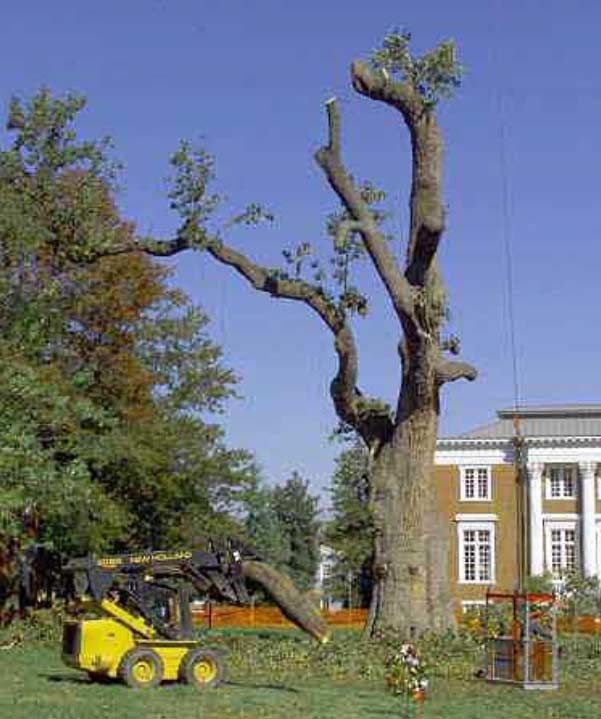
The End of Era
1992-2000: The First Golden Era
With the Liberty Tree dismantled, and nothing but a large hole left in its place, the decision was made to move the 2000 match to back campus.
St. John’s College won that year, but the magic of the Liberty Tree was gone, and a new generation of croquet players had to learn again how to please the Gods and bring them to their side.
The next era would begin with a loss, but would also find new traditions, new levels of excellence, and most importantly the continued evolution of the game we all love.
2001-2012
The Redemption Era
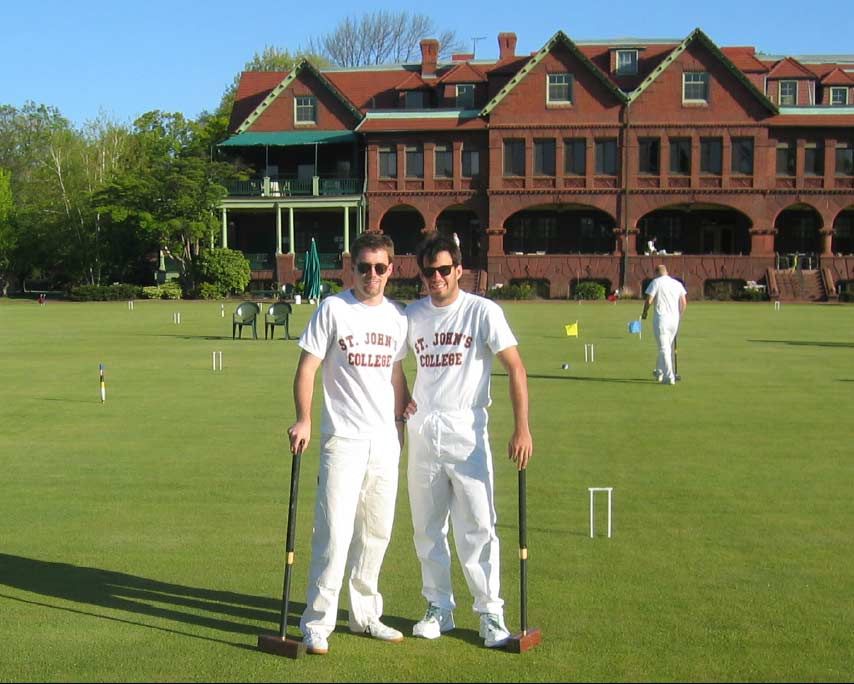
The Equipment
2001-2012: The Redemption Era
As interaction with the local and regional croquet clubs increased, the team was exposed to greater quality equipment. Oakley Woods became the standard SJC mallet, which were the slim majority of our Polity budget.
Sunshiny CQ16 balls became standard, due to cost, specifications required: 16 oz weight, 3-5/8" diameter, specific rebound rate and double milled surface.
The wickets used in play on front campus and against Navy could not be improved much over previous decades without an improvement to the lawn. Attempts to play with professional standard hoops on a bumpy, uneven surface would be near impossible and very frustrating.
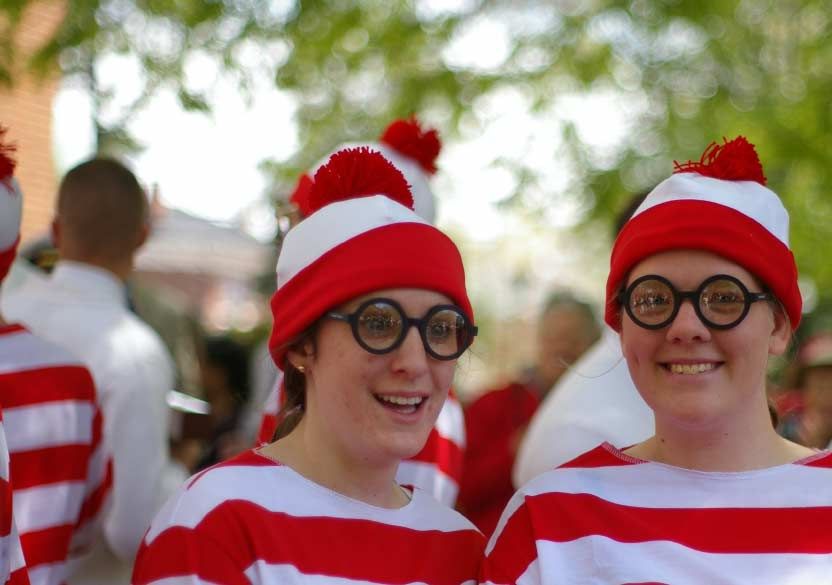
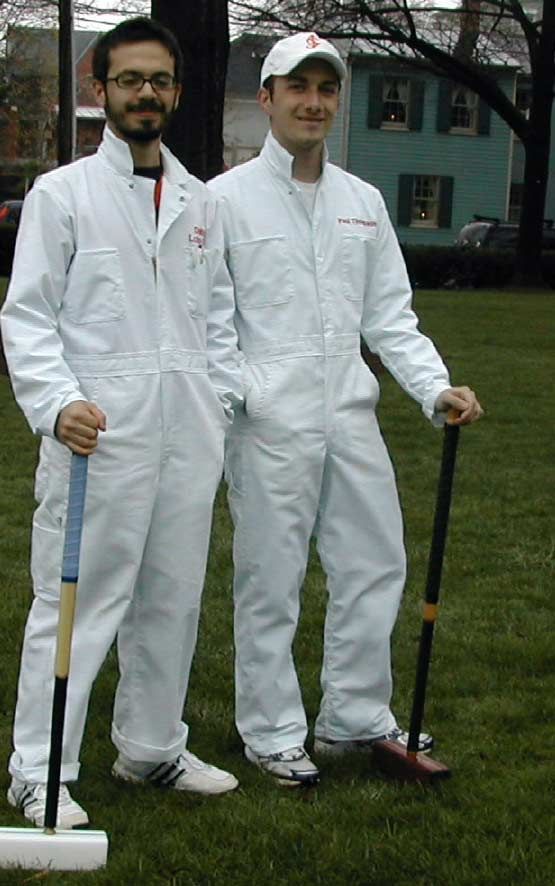
New Traditions
2001-2012: The Redemption Era
Also in this era, in April of 2003, the tradition of having a team uniform on the day of the Annapolis Cup began. Uniform themes have been as varied as the team can conceive.
There was the SJCCCP, the St. John’s Croquet Club Party, a group of Viking raiders to fight the Navy, public safety officers to keep things peaceful.
Perhaps the most memorable was a large group of Waldos from Where’s Waldo. The team keeps the uniform a secret from everyone until the Great Reveal as they come out of BBC and are introduced to the crowd.
A uniform for playing at Nationals was also developed in 2008, following the need to have all-white athletic attire at the Merion Cricket Club.
The team purchased white jump suits from automotiveworkwear.com, which look much like the caddies wear at the Masters Tournament.
This particular uniform has stuck as something to earn. If you played at Nationals, you have a jump suit, which may be rather more stained than white by this point.
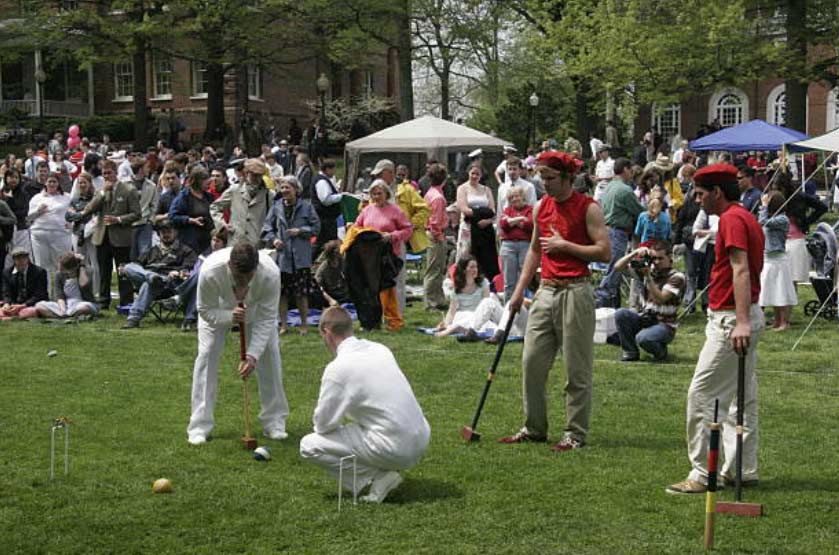
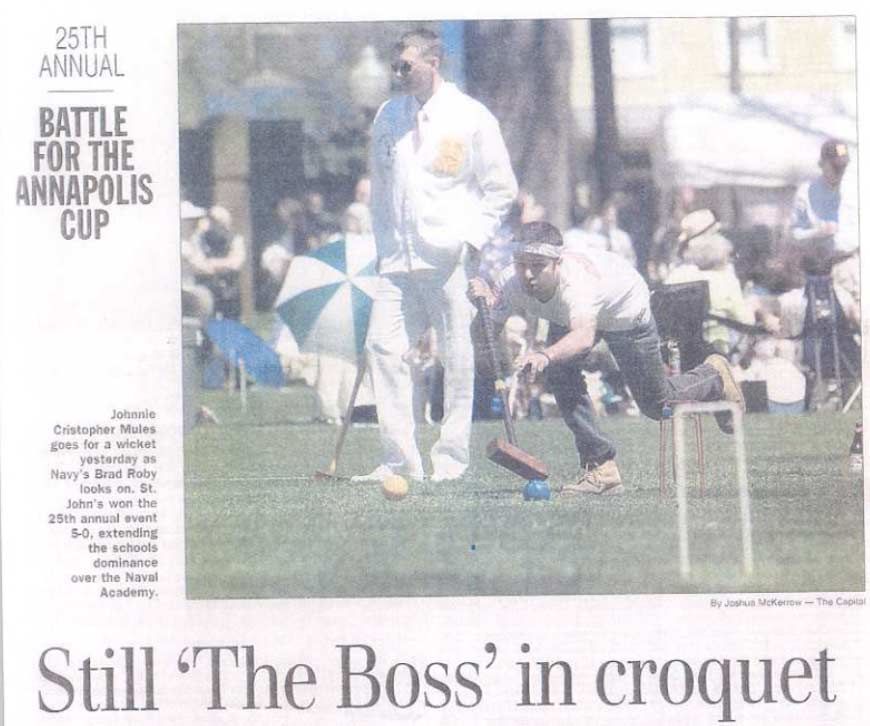
The Strategy
2001-2012: The Redemption Era
Improvement in equipment and experience with other clubs lead to a greater faith in the team’s ability to make more difficult shots with greater frequency.
The team began to learn more about the high levels of the game beyond college and soon a few of our players began to compete in tournaments after graduation and to acquit themselves with both τιμή and κλέος.
The three-ball break became the standard of how to play, with all strategy focused on how to acquire one and how to keep the opponents from starting one. This occurs when the striker’s ball uses two of the other balls on the court to take as many hoops in one turn as possible.
When executed properly, the game can be over very quickly. When failed, bad things loom.
The three-ball break is sometimes provided by an opponent’s mistake, laying out the required balls in opportune placement for the striker to begin.
More often (at least, in games involving more skilled players), it is required that a player needs to create the break out of an in-opportune situation, since a wise opponent is trying to NOT give it away.
As a result, the opening turns of the game became absolutely crucial and much more difficult for the casual observer to understand. “Why did they choose to play out of bounds instead of to their wicket?” is a very common question.
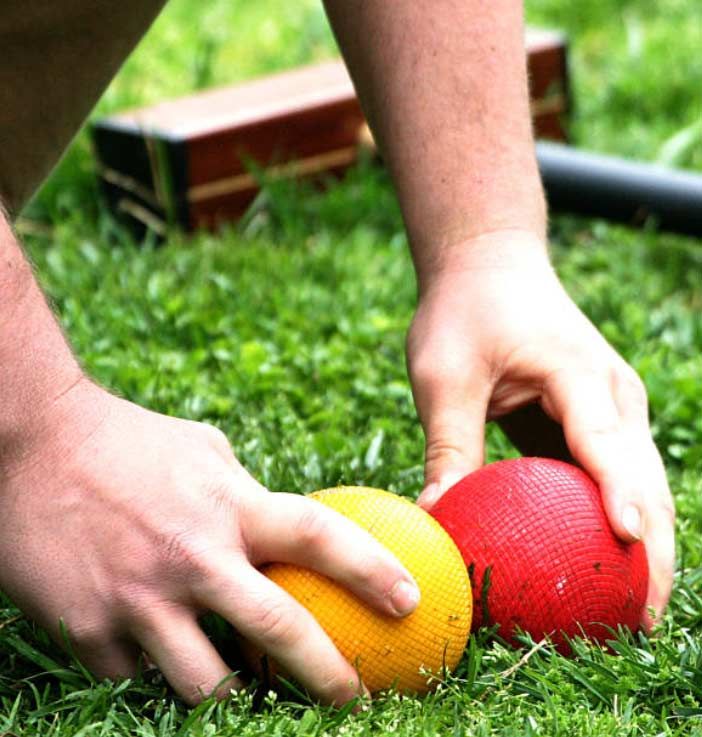
The Techniques
2001-2012: The Redemption Era
To run a three-ball break, competence and flawless execution are necessary, and with the lawn on front campus, a little bit of luck doesn’t hurt.
One must be able to hit two balls that begin the shot in contact (a “croquet”) in all manners that they can move, from the limit as one approaches a right angle to a zero-angle shot, from the croqueted ball moving only so much as to “quiver” to the croqueted ball moving nearly the length of the court, and from the striker ball moving not-at-all to nearly the length of the court. Both balls should be able to move any amount of these distances.
Once these easier parts are mastered, one must be able to call upon each of these varied skills at need as the striker ball attacks opponents to set up the break, runs the break, and sets a good break for partner ball. This usually will take 50-75 continuous successful shots to complete a three-ball break from a usual starting position.
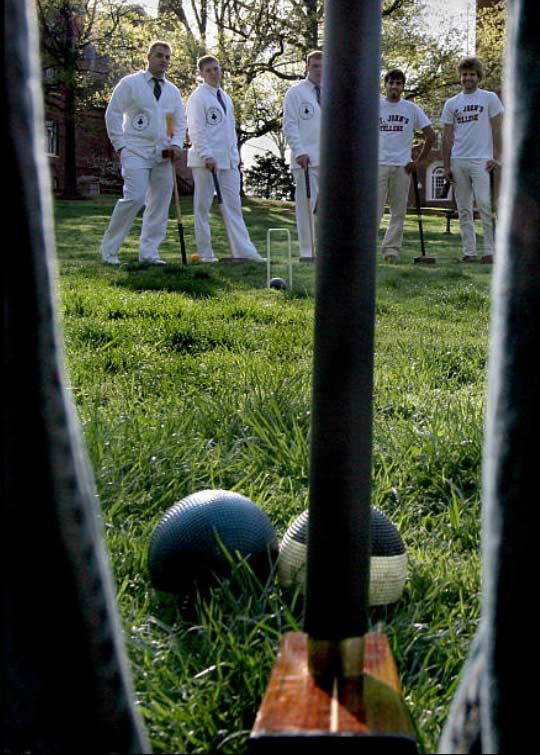
The Rules
2001-2012: The Redemption Era
The adoption of the USCA American Rules six-wicket croquet continued in the 2000s, even overturning some rules which no one could expect. Infinite Rover Rule was deemed too powerful as equipment and offensive play improved and it was quickly revoked so that the rover ball could only hit each of the other balls on the court once per turn, regardless of liveness.
A rover ball that was staked out still sat out of the game for two turns and then must stake back in at the turning stake.
The boundary line is not an ideal Euclidean line, but rather an actual string and out-of-bounds is defined as the center of the ball in question being completely over that string. Crush shots and double-taps were a greater part of our understanding of the game, but they remain a call that the striker must make, not anyone else on the court or the crowd.
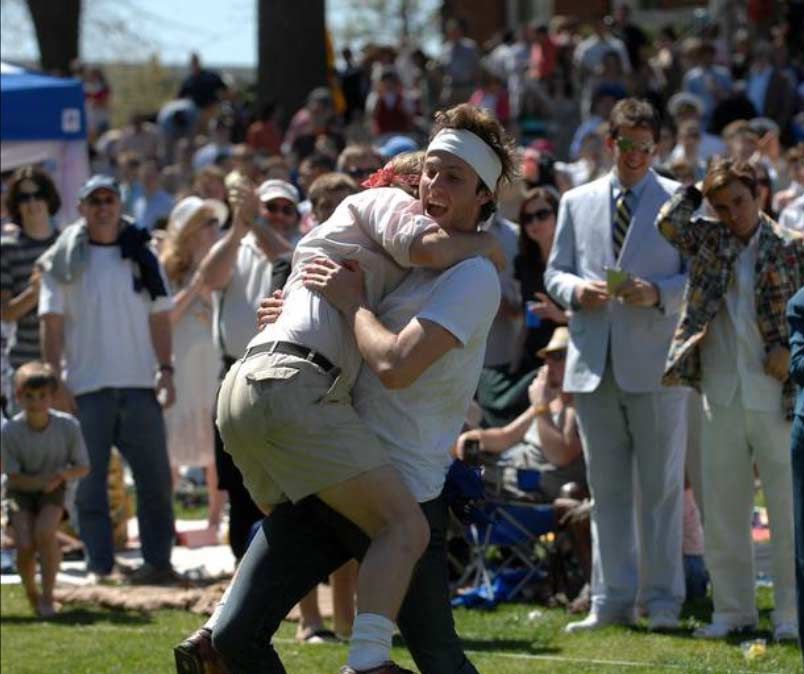
The Camaraderie
2001-2012: The Redemption Era
The slight hill of front campus on a sunny afternoon was always full of Johnnies and their activities, many of whom would be playing croquet and many more just joining in the fun. On a Friday afternoon before December or after March, it would be strange to have fewer than two courts up at the same time.
The idea of croquet as a St. John’s team and not as a number of students who enjoyed the game began to consolidate in this era, much to the chagrin of many, and it has continued apace.
When players of the current team talk of going to “practice,” it confuses players from this era. We didn’t have time to practice. We were playing too much.
If you didn’t play enough of your own volition, someone would be better than you and they would make the team. Camaraderie among the devotees of the game consisted in enjoyment and appreciation of great technical precision and Odysseus-like wisdom from one’s peer as well as celebrating φιλία.
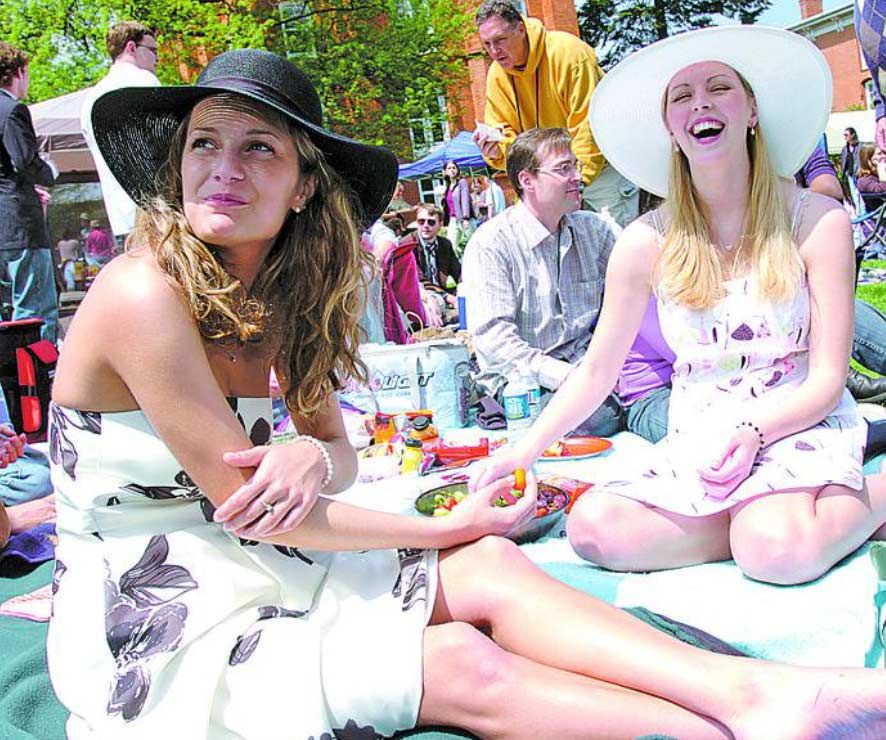
The Match Itself
2001-2012: The Redemption Era
In the 2000s, Annapolis Cups began as a casual affair with attendees wandering freely along and setting up their blankets and picnics and drinks wherever they’d choose. It ended with uncounted thousands coming inside the grounds and the college needing more security and personnel on the clock. By 2012, outside alcohol was prohibited, sponsor tents were being sold next to the courts, and vendors arrived.
The local and regional media picked up on the idea considerably at this point. There was a specific media day taking place before the match with the Navy team invited. There were newspaper, radio interviews, and multiple reporters on the scene, chronicling not only the match but the party, as well.
What the Players Say
2001-2012: The Redemption Era
When you look back on that era, they started without a Liberty Tree, and with
a loss. But they kept at it, and they got better. There were bumps along the
way, but they worked hard at the craft, and turned into some awesome
croquet players.
Nobody exemplified that gritty spirt more than Micah Beck. He was an
excellent tutor of the game, amiable, hilarious at times, but always driven to
be better than he was yesterday. You could see those teams respond to that,
and it made a huge impact on the culture of the team for the long term.
- Hardison Wood, Imperial Wicket: ’98
National Champion: ’97–’98, Annapolis Cup Champion: ’96–’98
2013-Present
The Pro Era
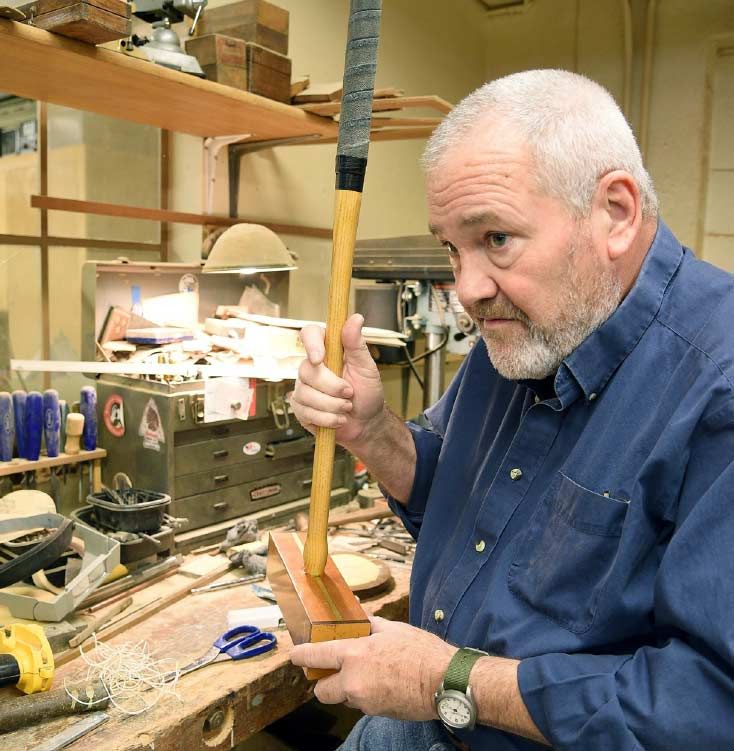
The Equipment
2013-Present: The Pro Era
During this time, Gary Dunkleberger, the mad genius who toils beneath Mellon Hall, added croquet mallets to his manufacturing repertoire (in addition to the more complicated equipment used in lab classes). These cherished keepsakes were made to specification and fully customizable. Gary also tirelessly restored the Annapolis Cup to its current form.
Ordering a “Gary mallet” was a rite of passage for new players after they had committed to learning the game at a high level. Many of these mallets were constructed with the cherry wood from retired seminar tables (and the lead capped with seminar chairs) and have become treasured pieces among those lucky enough to own one.
Receiving a white jumpsuit (a way for players to inexpensively wear white for more official tournaments) was still a tradition that occurred when a player officially made the team.
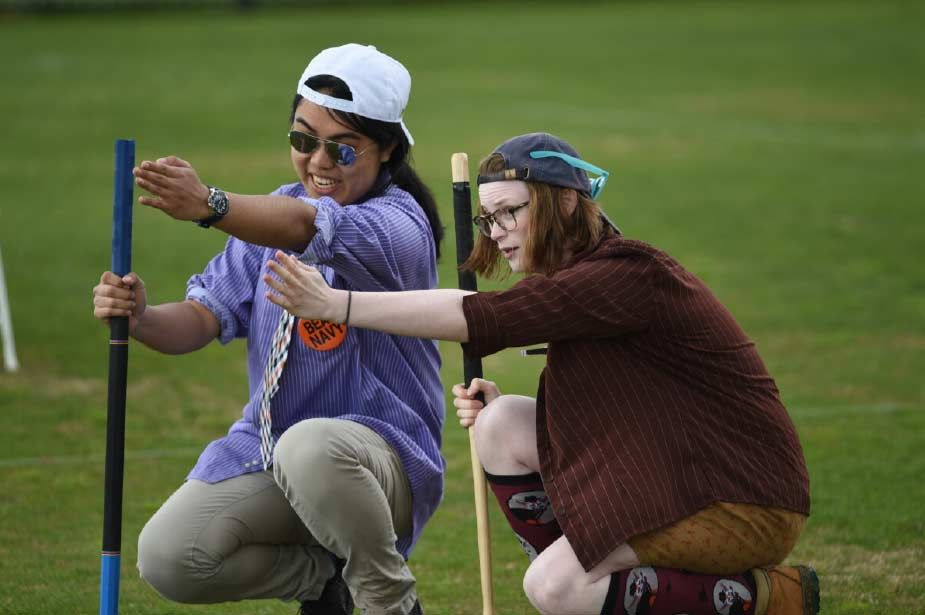
The Strategy
2013-Present: The Pro Era
The strategy during this era largely consisted of one player “going rover” (running all the wickets) as soon as possible and then subsequently assisting their partner by setting up their own break to end the game.
This efficiency was made possible through three-ball breaks. Learning how to properly execute a full three ball break was a litmus test of the best players and was often used to determine the teams that would play in the Annapolis Cup.
On defense, “guarding wickets” was a common strategy. Players would go out of bounds at strategic places where they knew the opponent may expose themselves to a counterattack. This was equal parts game and mind game, and a microcosm of the exceedingly cerebral nature of the strategy employed in this era.
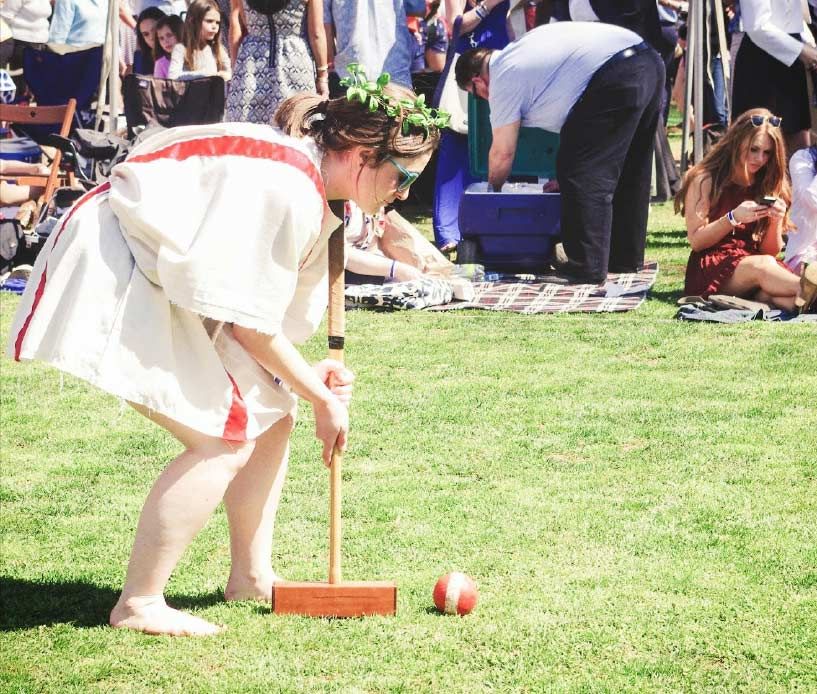
The Techniques
2013-Present: The Pro Era
Long shots became mandatory to get players back in the game, should they have taken any deadness after a failed break attempt. Long hoop shots to clear deadness were common as well as shots that, if they missed, would go safely out of bounds. The wickets that were in use were much more forgiving than the hoops played on professional courts, and more angled shots were possible.
Mastering the techniques necessary to conquer the long grass of the front campus lawn became a necessity, especially as the players of this era were exposed to manicured croquet courts.
All types of rolls were practiced regularly: full rolls, half rolls, stop shots, take-offs, pass rolls, drive shots, 1/4 rolls, 3/4 rolls, spring rolls, tuna rolls, and tootsie rolls alike. The game was being played at its highest level yet and the techniques used were no exception.
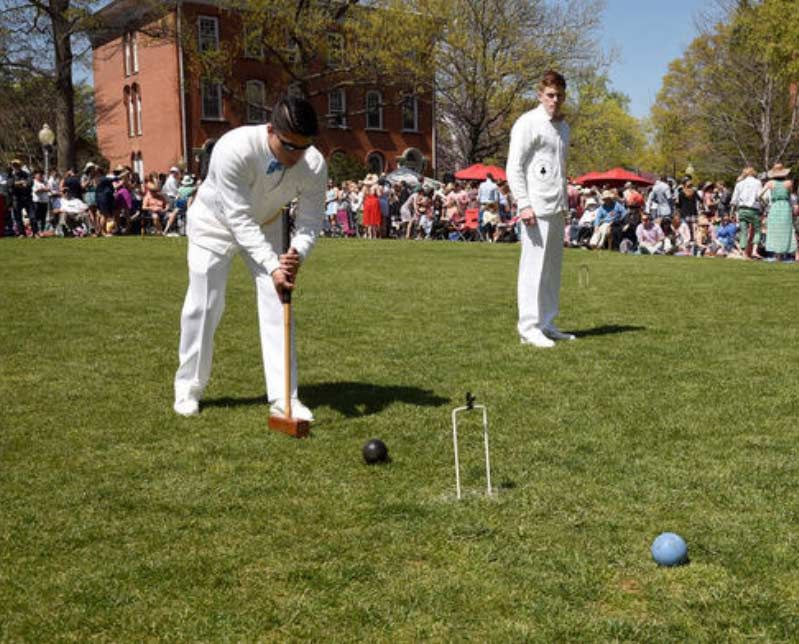
The Rules
2013-Present: The Pro Era
The rules in this era remained undeniably idiosyncratic, as the Annapolis Cup was played with rules similar to American
Rules croquet but played within a nine-wicket formation (as American Rules is a six-wicket game).
We no longer used the infinite rover rule at this point, but kept the unique rover stake out rule in effect. If there were any intended changes to the rules for a given match, the Wickets from both teams would meet and discuss before the match.
STILL NO TIME. AND NEVER SHALL THERE BE!
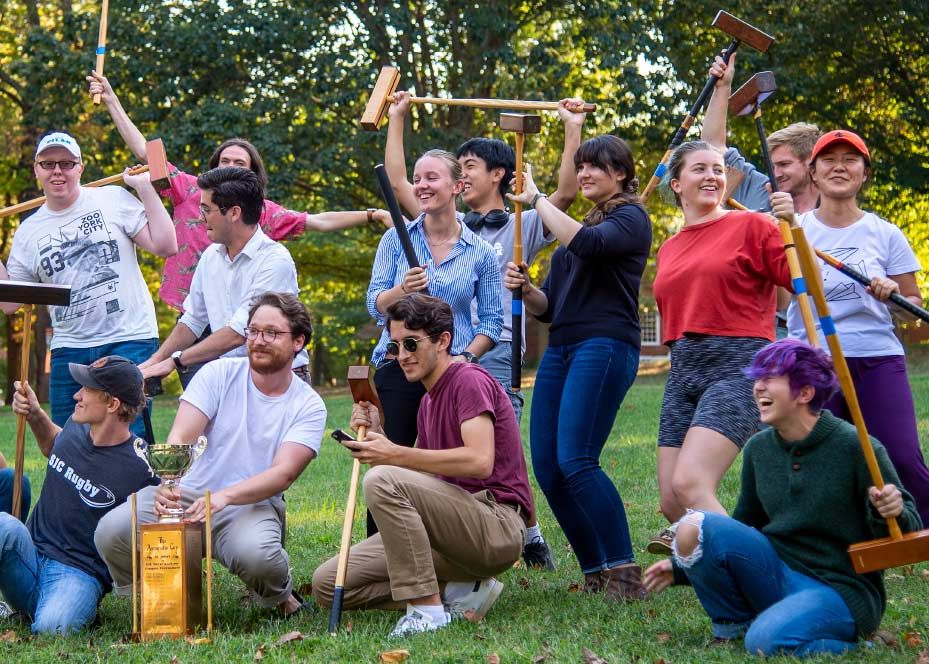
The Camaraderie
2013-Present: The Pro Era
The game itself advanced to a much higher level of strategy, techniques, and general skill—but the foundation of playing croquet for fun was still an integral part of croquet.
The team also began to host more campus-wide events, namely grilling various foods or hosting general get togethers with the Polity.
The team began to take more trips to other croquet clubs, including Pinehurst, the Chesapeake Bay Club, and the National Croquet Center.

The Match Itself
2013-Present: The Pro Era
The team employed some specific strategies during the Annapolis Cup around this time to exploit the weaknesses of the Midshipmen, namely “chase theory.” For example, players would play out of bounds early in order to stay behind the opponents’ position and eventually take advantage of any mistakes (in the form of three-ball breaks).
The matches, however, were often close due to the vast differences in strategies between the team and the USNA. Midshipmen were known to utilize just their partner and “two-ball” together through the court. If they made a mistake, the Johnnies would pounce and run the threeball (or even the four-ball) break. But if the Johnnies made a mistake, or let the Midshipmen get too far ahead, they could find themselves behind very quickly.
There were many thousands in attendance, and the event could get rowdy should it last over a few hours. It was important during this era to tread carefully around the drunken Midshipmen, who were often in foul moods as they watched yet another goat-roasting.
What the Players Say
2013-Present: The Pro Era
This era’s chapter is still being written. But while we started out with the first
ever consecutive losses to Navy, we righted the ship quickly. Then COVID
came and that was a set back. We cannot thank Mia Kobylski and James
Bienamen enough for their vigorous and timely work at keeping the heart of
the team still beating.
With active alumni support from the Rusty Wickets, and with assistance from
recent nationally and internationally ranked graduates, the future is bright for
the SJC Croquet Team!
- Sam Collins, Imperial Wicket: ’14 -’15
National Champion: ’15, Annapolis Cup Champion: ’15
What Comes Next?
The truth is, we don’t know. A new era is already upon us, the post-Covid years ... What they bring to the team we cannot predict. What we do know is that the Rusty Wickets will continue to offer support to the team, that the team will likely just keep getting better and better, and that the next 40 years of unfettered passion will probably feature the same beguiling events as the first, but altogether different, meaningful, and we trust … fun-filled. We hope you’ve enjoyed getting to learn a little bit about the history of this event, the team, and the game itself. If you have any croquet related questions throughout the day, find a Rusty Wicket and ask them for a brief explainer … emphasis on the word “brief” (they are Johnnies after all). –The Rusty Wickets
40 Years of Unfettered Passion
- 1983 – SJC
- 1984 – SJC
- 1985 – USNA
- 1986 – SJC
- 1987 – USNA
- 1988 – SJC
- 1989 – SJC
- 1990 – SJC
- 1991 – USNA
- 1992 – SJC
- 1993 – SJC
- 1994 – SJC
- 1995 – SJC
- 1996 – SJC
- 1997 – SJC
- 1998 – SJC
- 1999 – SJC
- 2000 – SJC
- 2001 – USNA
- 2002 – SJC
- 2003 – SJC
- 2004 – SJC
- 2005 – USNA
- 2006 – SJC
- 2007 – SJC
- 2008 – SJC
- 2009 – SJC
- 2010 – SJC
- 2011 – SJC
- 2012 – SJC
- 2013 – USNA
- 2014 – USNA
- 2015 – SJC
- 2016 – SJC
- 2017 – SJC
- 2018 – SJC
- 2019 – SJC
- 2020 – cancelled
- 2021 – cancelled
- 2022 – USNA
A Tradition of Excellence: USCA Collegiate National Championships - American Rules
- 1996 – 2nd Place
- 1997 – Champions
- 1998 – Champions
- 1999 – Champions
- 2007 – Champions
- 2008 – Champions
- 2009 – Champions
- 2010 – Champions
- 2000 – Champions
- 2004 – Champions
- 2005 – Champions
- 2006 – Champions
- 2013 – Champions
- 2015 – Champions
- 2016 – Champions
- 2018 – Champions
- 2019 – Champions
The Teams Themselves
2023 Croquet Team
- Mia Kobylski & James Bieneman - IWs
- Agnes Galvin
- Liz Meade
- Joseph Bennet
- Tom Ni
- Peter Boeresma
- Caden Marshall
- Mirek Jungr
- Magnus Oberg
- Madison Grohman
- Agnus Preston
- Quinlyn Bright
2022 Croquet Team
- Mia Kobylski & James Bieneman - IWs
- Connor Shin
- Agnes Galvin
- Liz Meade
- Grace Miller
- Tom Ni
- Sam Soderlund
- Caden Marshall
- Vinnie Strong
- Josephine Dowd
- Mirek Jungr
- Magnus Oberg
2019 Croquet Team
- Alex Muradian & Mack McGowen – IWs
- Sean Miller & Charlie Carpenter
- Mitchell Harris & Val Pehrson
- Sam Cooper & Alex Kwilinski
- Jared Bassman & Tom Balding
2018 Croquet Team
- Shane Hettler, IW
- Tom Balding
- Jared Bassman
- Charlie Carpenter
- Rhys Davis
- John Jane, III
- Robin Lancaster
- Mack McGowen
- Sean Miller
- Alex Muradian
- Subha Niroula (King of Ct. 3)
- Tyler Snyder
- Mifield Xu
2017 Croquet Team
- Mifield Xu
- Stephanie Hurn
- Robin Lancaster
- Jared Bassman
- Rhys Davis
- Mack McGowen
- Tyler Snyder
- John Jane, III
- Subha Niroula (Prince of Ct. 3)
- Joe Gillespie-Hill
- Shane Hettler
- Stefan Vasic
- Sean Miller
2016 Croquet Team
- Noe Jimenez - Brooklyn, NY – IW
- Joe Gillespie-Hill - Huber Heights, OH
- Stephanie Hurn - Darien, CT
- Stefan Vasic - Woodstock, VA
- Shane Hettler - Los Angeles, CA
- Max Khanjari, - Silver Spring, MD
- Subha Niroula - Biratnagar, Nepal (Ct. 3 baby)
- Matthew Saburn - Basking Ridge, NJ
- Mifield Xu - Hangzhou, China
- Rhys Davis - Arlington, VA
- Mack McGowen - Angleton, TX
- Alex Muradian - Washington D.C.
2015 Croquet Team
- Samuel Collins - Fallsington, PA - IW
- Matthew Denci - East Greenwich, RI
- Jack Whitman - Escanaba, MI
- Dylan Tyler - Fallston, MD
- Sebastian Abella - Miami, FL
- Jennifer Shumpert - Reston, VA
- Joe Gillespie-Hill - Dayton, OH
- Stefan Vasic - Woodstock, VA
- Stephanie Hurn - Darien, CT
- Noé Jimenez - Brooklyn, NY
- Shane Hettler - Los Angeles, CA
- Ambrose Donnelly - Chicago, IL
2014 Croquet Team
- Samuel Collins -Fallsington, PA - IW
- Amanda Glasgo - Loudonville, OH
- Ethan Goddard -Moultonboro, NH
- Hayden Pendergrass - El Paso, TX
- Catherine Moon - Wolcott, CT
- Dylan Tyler - Fallston, MD
- John Whitman - Escanaba, MI
- Sebastian Abella` - Miami, FL
- Matthew Denci - East Greenwich, RI
- Stefan Vasic - Woodstock, VA
- Stephanie Hurn - Darien, CT
- Joseph Gillespie-Hill - Bloomsburg, PA
- Hector Mendoza - Tucson, AZ
2013 Croquet Team
- Drew Menzer - Granville, OH - IW
- Jonathan Barone - Waterbury Ctr, VT
- Cory Cotten-Potter – Newport News, VA
- Hunter Cox- Hartland, VT
- Rachel Hahn - Sebewaing, MI
- Daniel Popov - Moscow, Russia
- Phil Schiffrin - Wynnewood, PA
- Eric Shlifer - Poulsbo, WA
- Mandee Glasgo – Loudonville, OH
- Hector Mendoza - Tucson, AZ
- Samuel Collins - Fallsington, PA
- Dylan Tyler - Fallston, MD
2012 Croquet Team
- John Fleming – Gaithersburg, MD - IW
- Sam Frank – Kenneth Square, PA
- Linus Feder – Montclair, NJ
- Jonathan Tincher – Dunbar, WV
- Noah Litvin – Mamaroneck, NY
- Luke Wakeen – Wilton, CT
- Daniel Popov – Irvington, NY
- Drew Menzer – Granville, OH
- Eric Shlifer – Poulsbo, WA
- Phil Schiffrin – Wynnewood, PA
- Hunter Cox – Hartland, VT
- Jonathan Barone – Duxbury, VT
2011 Croquet Team
- Blake Myers, 2011 - IW
- John Dusenbury, 2011
- Linus Feder, 2012
- John Fleming, 2012
- Sam Frank, 2012
- Noah Litvin, 2012
- Stephen Monteiro, 2011
- Thomas Myers, 2011
- Clayton “Tex” Pasley, 2011
- Andrew Peak, 2011
- Johathan Tincher, 2012
- Luke Wakeen, 2012
2010 Croquet Team
- Cameron Coates, 2010 - IW
- Dan Connelly, 2010
- Pavlos Papadopoulos, 2010
- Ben Hutchins, 2010
- Chris Gentry, 2011
- Thomas Myers, 2011
- Tex Pasley, 2011
- Blake Myers, 2011
- John Dusenbury, 2011
- Johnnie Fleming, 2012
- Peter White, 2012
- Jonathan Tincher, 2012
- Sam Frank 2012 – National team only
- Paul Morrell 2010 – National team only
2009 Croquet Team
- Micah Beck A09 - IW
- Cameron Coates A10
- Clint Richardson A09
- Jake Crabbs A09
- Dan Connelly A10
- Ben Hutchins A10
- Nate Oesch A09
- Pavlos Papadapoulos A10
- Matt Butler A09
- Patrick Rieder A09
- Dalton Lobo Dias A09
- Paul Thompson A09
- 2008 Croquet Team
- Ian Hanover, 2008 - IW
- Charlie Fleming, 2008
- Charlie Gillmarten, 2008
- Phil Lazzara, 2008
- Tristan Evans-Wilent, 2008
- Shunji Matsuzawa, 2008
- Rook Singer, 2008
- Rachael Boyce, 2008
- Adam Meyers, 2008
- Clare Saunders, 2008
- Micah Beck, 2009
- Clint Richardson, 2009
2007 Croquet Team
- Rob Hurst, 2007
- Ian Hanover, 2008
- Tristan Evans-Wilent, 2008
- Chris Mules, 2007
- Logan Smith, 2007
2006 Croquet Team
- Matt Mangold - IW
- Rob Hurst
- Tommy Dyer
- Micah Beck
- Ian Hanover
- Charlie Fleming
- Michael Ward
- Geremy Coy
- Paul Patrone
- Andrew MacKinlay
- Exhibition:
- Will Kelly
- Dan Houck
2005 Croquet Team
- Nick Whittier - IW
- Chris Mules
- Tristan Evans-Wilent
- Cara Lammey
- John Gerard
- Michael Ossorgin
- Shunji Matsuzawa
- Dan Houck
- Paul Patrone
- Michael Ward
- Tommy Dyer
- Matt Mangold
2004 Croquet Team
- Justin Berrier
- Sam Spalding
- (Geoffrey) Ian Morochnick
- Aurora “Rey” Cassells
- Jackson “Pants” O’Brien
- Nick Whittier
- ???
2003 Croquet Team
- Ben Porter - IW
- ???
2002 Croquet Team
- Jonathan Polk - IW
- ???
2001 Croquet Team
- Paige Postlewait - IW
- Lucas Ford
- David Jennings
- Wyatt Dowling
- Jonathan Polk
- ???
2000 Croquet Team
- Robert (Bob) Dickson - IW
- Ben Young
- Michael Behmer
- John Lawless
- Mark Alznauer
- Nate Carpenter
- Matt Calise
- Tim Carney
- Mike Busch
- Paige Postlewait
- Exhibition:
- Galen Nuttall
- Lucas Ford
1999 Croquet Team
- Ryan “The Phenomenon” Simpson - IW
- Thad Finlayson
- Christian Moser
- Piroshka Koper
- Sam Davidoff
- Isaac Opalinsky
- Tim Carney
- ???
1998 Croquet Team
- Hardison Wood - IW
- Josh Rogers
- Aaron Pease
- Rich Bravo
- Ben Sullivan
- Tom Kurland
- Ryan Simpson
- Dan Lee
- Christian Moser
- Samuel Davidoff
1997 Croquet Team
- Kit Linton & Jon Andrews - IWs
- Remington Korper
- Hardison Wood
- Josh Rogers
- Aaron Pease
- Rich Bravo
- ???
1996 Croquet Team
- James Knerr - IW
- John Sifton
- Jon Andrews
- Kit Linton
- Hardison Wood
- Matthew Caswell
- Jonathan Spooner
- Dara Trought
- ???
1995 Croquet Team
- Craig Sirkin - IW
- Micah Pharris
- Ned Freeman
- John Sifton
- Brian Baker
- Reuben Marshall
- Matthew Caswell
- ???
1994 Croquet Team
- Ben Power - IW
- Craig Sirkin
- Ann Grabhorn
- Abe Schoener (tutor)
- Paul Morf (or Morph)
- Reuben Marshall
- Ned (Edward) Freeman III
- John Crimmins
- James Shaka Knerr
- John Sifton
1993 Croquet Team
- Alejandro “Alex” Valleja - IW
- Walter Sterling
- Brian Tracey
- Abe Schoener (tutor)
- Ben Power
- Bruce Frieseke
- Panayiotis “Panos” Pappas
- Michael Camper
- Craig Sirkin
- Alfred Bennett, Jr.
1992 Croquet Team
- Eric Traynor - IW
- Bryan Tracey
- Walter Sterling
- Alex Vallega
- Brian Baker
- Abe Schoener
- Panos Pappas
- Benjamin Power
- Craig LeFevre
- Wes Donehower
1991 Croquet Team
- Louis Elias - IW
- Eric Traynor
- Panos Pappas
- Theresa Klunk
- Ed Prud’homme (Mills Edwin)
- Andy Pietrus
- ???
1990 Croquet Team
- ???
1989 Croquet Team
- ???
1988 Croquet Team
- Bob Demajistre - IW
- ???
1987 Croquet Team
- Bob Demajistre - IW
- ???
1986 Croquet Team
- Kate Kelly - IW
- Pam Halkett
- Casey Carter
1985 Croquet Team
- Steven Werlin - IW
- James Hapner
- Michael Slakey
- Ken Shen
- Andrew Beckman
- John C. Baldy (Polity President)
- Bryce Jacobsen
- “The Great” David Kidd
1984 Croquet Team
- ???
1983 Croquet Team
- John Ertle - IW
- James Hapner
- Katie Kelly
- Kate O’Malley
- Adrian Trevisan
- John Mckee
- Drew Parker
- Steve Werlin


